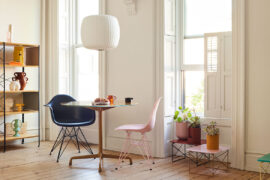It’s mass produced, it’s global, it’s on-trend and it’s inexpensive. Against all odds COS has created something wonderful and in it there’s a lesson for us all.
February 17th, 2017
Since opening their doors onto London’s Regent Street in 2007, the COS fashion label has stayed true to their founding principals of re-inventing classics with modern, timeless, functional and tactile designs. In the ten years since, they have created a global presence and appeal; forged strong connections with the art and design world; and remained at the forefront of social initiatives and industry innovation.
“We are proud of how the brand has grown over the last ten years. We are pleased and humbled that our customers have continued to appreciate our approach and engage with our collections, stores and collaborative projects with the art and design world,” says Marie Honda, COS Managing Director.
To celebrate their decade-long anniversary they have released a 10-piece capsule collection of mens- womens- and childrenswear. Uniquely, each garment’s pattern is created like a jigsaw puzzle using the full width of the fabric roll, one shape deciding another, limiting any excess. The clean and considered collection is in line with the now iconic COS aesthetic.
This then begs the question should the architecture and design community be taking notes from the fashion industry? Can we do something similar? Can we at least try? Surely this wasn’t easy but an ingenious team of designers behind the COS label prove it’s far from impossible.
Would it be possible to create furniture without creating waste? That may seem feasible on an individual, bespoke level, but what about mass production for the masses? After all that’s exactly where the majority of waste comes from. COS did it. Let’s take it a step further to architecture. Can we look towards building homes, apartment complexes, hospitality and retail spaces – from the outside in – without leaving behind offcuts and wasted materials?
How can we repurpose this amazing and thoughtful initiative?
INDESIGN is on instagram
Follow @indesignlive
A searchable and comprehensive guide for specifying leading products and their suppliers
Keep up to date with the latest and greatest from our industry BFF's!

How can design empower the individual in a workplace transforming from a place to an activity? Here, Design Director Joel Sampson reveals how prioritising human needs – including agency, privacy, pause and connection – and leveraging responsive spatial solutions like the Herman Miller Bay Work Pod is key to crafting engaging and radically inclusive hybrid environments.
The new range features slabs with warm, earthy palettes that lend a sense of organic luxury to every space.
The internet never sleeps! Here's the stuff you might have missed

For three-quarters of a century, the iconic Eames Shell Chair has redefined the very act of sitting with its groundbreaking form, proving that, rather than restrict, the right mould can embrace every space, need and individual aspiration.

Thursday 31st July – the 2025 INDE.Awards Gala is set to go off at Saltbox, part of Sydney’s Wunderlich Lane precinct.